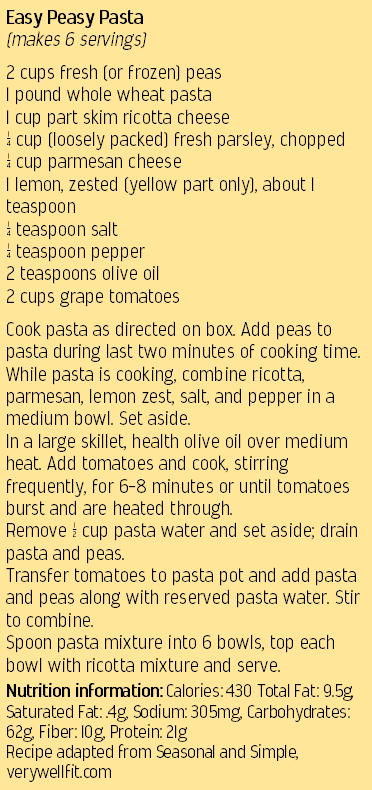|
 by Denise Sullivan, Nutrition and Health Education Specialist, MU Extension Outside of lettuce or other types of leafy greens, peas are one of the early season garden goodies I look forward to every year. While some people might find the shelling of peas a tedious task, I prefer it to snapping beans and find it rather satisfying to ‘zip’ open the pod to get to the treasure inside.
For most purposes, peas may be classified as garden or English peas, snow peas, and sugar snap peas. English peas are further divided into smooth or wrinkled seed varieties. Smooth-seeded varieties are starchier, while wrinkled varieties are sweeter and are commonly used for home and commercial growing. Snow peas are meant to be harvested as flat, tender pods before the peas inside develop at all. Sugar snap peas have been developed from garden peas to have low-fiber pods that can be snapped and eaten along with the slightly mature peas inside. The starchier smooth-seeded varieties are used to produce ripe seed kernels that are fractured to be used to make split-pea soup. The Southern pea, or cowpea is an entirely different vegetable that is planted and grown in the same manner as beans and legumes. In the mid 1900’s, studies by Gregor Mendel working with seven characteristics of pea plants (plant height, pod shape and color, seed shape and color, and flower position and color) laid the foundation for modern genetics by identifying dominant and recessive traits in organisms. Peas are the seed of the Pisum sativum plant, which originated in the Mediterranean region of Greece, Syria & Turkey. They are a frost-hardy, cool-season vegetable grown wherever a cool season of sufficient duration exists. Today, most production occurring outside of the United States is in colder regions like Canada, Russia, England, and France. The highest producing states in the US are Washington, Montana, and North Dakota. No matter how you roll them, peas are nutrient-dense packages of carbohydrates, protein, fiber, vitamins, and minerals (especially iron, potassium, folate and vitamins A and K). A half-cup of cooked green peas contains 4 grams of protein, 4 grams of fiber, 12 grams of carbohydrate, and 641 IU of vitamin A. On the flip side, peas also contain phytic acid and lectins, which are often referred to as anti-nutrients, that may interfere with nutrient absorption and promote bloating in some people. To minimize these effects keep serving sizes to around 1/3 to ½ cup, eat them fully cooked instead of raw, and try sprouted or fermented preparations. Peas can be enjoyed alone as a side dish, or added into soups, stews, or salads. Green peas can even be baked (tossed with a little olive oil and spices) on a baking sheet for a healthy, crunchy snack. Combining fresh peas with grape tomatoes, the pasta dish below can be served warm as a hearty main dish or chilled as a salad by thinning the cheese mixture with lemon juice. Denise Sullivan is a Nutrition and Health Education Specialist for MU Extension in the Urban West Region, serving Jackson and Platte Counties. For research-based nutrition and food safety information and programs, visit https://extension.missouri.edu/counties/urban-west-region Comments are closed.
|
Categories
All
Archives
July 2024
|
Grain Valley NewsGrain Valley News is a free community news source published weekly online. |
Contact Us |



 RSS Feed
RSS Feed
